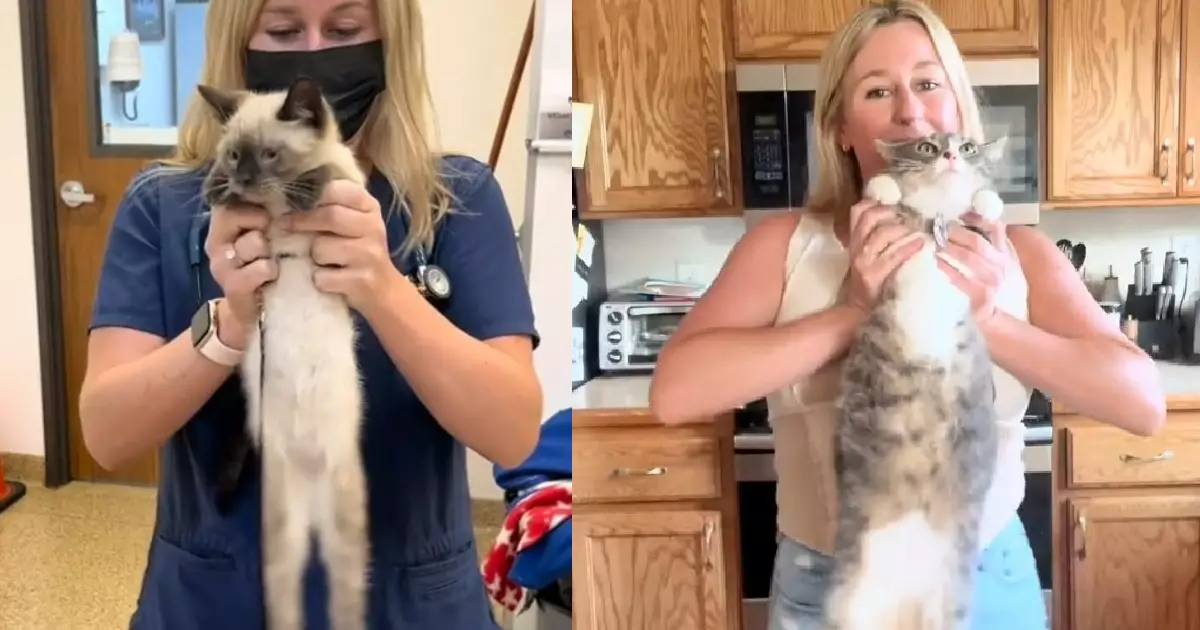In a digital age where scientific rigor often dominates our understanding of pet behavior, it’s refreshing—and perhaps a little rebellious—to revisit traditional methods. The so-called “dangle test,” an old wives’ tale from veterinary lore, has recently resurfaced in social media circles, captivating millions with its playful premise: can the way a cat reacts to being gently dangled predict its future temperament? While skepticism is warranted, this cultural phenomenon invites us to question how much of our pet care is rooted in empirical evidence versus anecdotal tradition. The viral spread of this test underscores our innate desire to decode our feline friends’ personalities through simple, accessible techniques, even if their scientific validity remains questionable.
Traditionally, pet owners and veterinarians have relied on instinct, anecdotal evidence, and experience to gauge a cat’s temperament. The “dangle test” adds a twist to this age-old approach by offering a seemingly straightforward, visual indicator. Its resurgence on platforms like TikTok reflects our collective hunger for instant, easy-to-understand methods of reading animal behavior. But more than that, it echoes a deeper human tendency: seeking control and predictability over unpredictable creatures. The fact that millions are engaging with this test suggests a yearning for connection, understanding, and perhaps even a bit of fun in the sometimes intimidating world of pet psychology.
The Cultural and Psychological Appeal of the “Dangle Test”
What makes the “dangle test” so engaging is its simplicity and the playful spirit it embodies. Pet owners, often eager to demonstrate how well they understand their cats, are willing to suspend their pets (literally) as a test of patience or temperament. The viral videos showcase cats responding with a range of reactions—from chill acceptance to wildly inappropriate playfulness—which many interpret as echoes of their true personalities. These clips aren’t just about quirky humor; they symbolize a collective attempt to interpret the mysterious feline psyche through an age-old, almost ritualistic act.
On a psychological level, attempting such a test provides a sense of agency. It offers a tangible, observable phenomenon—dangle, watch, interpret—that gives pet owners an illusion of mastery over their pet’s nature. Even if the test lacks robust scientific backing, it fosters engagement and a sense of community among pet lovers. With millions sharing their results—sometimes delightfully confirming and other times hilariously incongruous—these moments become bonding experiences rooted in shared humor and curiosity.
The test’s popularity also reveals a desire for quick assessments that promise insight without needing extensive behavioral studies. In a society characterized by rapid information consumption, the “dangle test” fits perfectly—easy to perform, humorous to share, and visually compelling enough to go viral. It exemplifies how cultural trends often prioritize entertainment and relatability over empirical truth, highlighting a tension between scientific skepticism and human desire for quick solutions.
Critical Perspectives: Is the “Dangle Test” Valid or Vitally Flawed?
Despite its charm, the “dangle test” raises important questions about the risks of relying on unverified methods in pet psychology. From a scientific standpoint, hanging a cat or any animal as a behavioral gauge is inherently flawed and potentially harmful if misinterpreted. While most cats tolerate gentle dangling without apparent distress, the risk of causing undue stress, fear, or even injury remains. Moreover, a cat’s reaction to being dangled does not reliably predict its overall temperament or suitability as a pet. It is merely a snapshot of a moment—one that could be influenced by myriad factors like mood, environment, or even the time of day.
Veterinary professionals rightly caution against taking such tests as definitive. Behavior is nuanced and shaped by genetics, environment, socialization, and past experiences. Simplistic tests risk reducing complex personalities into binary outcomes—good or bad, chill or fussy—that do little to inform responsible pet ownership. Furthermore, emphasizing such methods can inadvertently normalize behavior that is stress-inducing or disrespectful, undermining efforts to promote humane and considerate treatment.
Nonetheless, the “dangle test” exists more as a social and cultural phenomenon than a scientific tool. It’s seen as a humorous, light-hearted experiment—one that, when performed responsibly, can become a playful engagement with a pet’s quirks. But it should never replace comprehensive behavioral assessments or professional advice. The allure of a quick, visual “measurement” shouldn’t obscure the importance of understanding individual animals through respectful observation and patience.
The Future of Traditional Methods in a Digital World
This viral phenomenon underscores a broader conversation: how do traditional wisdom, anecdotal methods, and scientific evidence interact in modern animal care? The “dangle test” symbolizes a tension—a nostalgic nod to old-school intuition and a society hungry for instant gratification. While veterinary science offers sophisticated tools for assessing feline behavior—like temperament tests, environmental assessments, and behavioral therapy—these are often esoteric and inaccessible to the average pet owner.
The challenge lies in integrating the charm of these traditional practices with responsible, science-based care. Education must evolve to respect the cultural significance of stories like the “dangle test” while emphasizing humane treatment and evidence-based practices. Pet owners should be encouraged to use humor and curiosity as gateways to deeper understanding, not as substitutes for professional advice.
In the end, the viral popularity of this feline “test” reveals a universal truth: humans love stories. Whether rooted in science or tradition, stories and shared experiences forge connections. The “dangle test” may not hold scientific water, but it undoubtedly holds cultural weight—highlighting our ongoing quest to understand and connect with the creatures that brighten our lives.


Leave a Reply